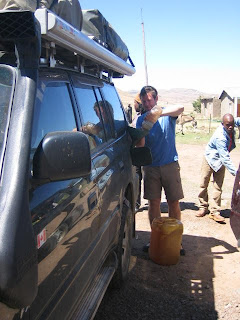

October 12th, 2008- still the same day
The fun we had with the children would soon fade as we noticed our petrol was nearing empty. Also of note was that our water tank too was empty. Unfortunately we were ill prepared for Lesotho, as we quickly got used to the comforts of South Africa. However we weren’t too worried as our map marked a settlement. This was would be the first village we would go to which was actually marked on the map. We arrived at Semhonghong and asked where the petrol station was. No English. Diesel? No diesel, that was clear. Where diesel? Puzzled looks. Pointing towards the south. And off we went again.
We stopped every person we encountered, slowing at village after village asking about fuel. No dice. The ‘empty’ light lit. Mother F$%^er. Next village. Diesel? At last an English speaker. Thank the lord. No diesel here. Far, far away. One day’s walk. F$%^. Diesel? Another English speaker. No diesel here. Far, far away. Three hours horse ride. F$%^. Diesel? No diesel here, down hill, long ways. Sehlabahlebe, diesel there.
No idea where we were, or how far it would be to Sehlabahlebe, Karel and I both wondered when the car would stop, silently pondering our fate, not wanting to say anything out loud as it might seal our fate. Hopefully not while we were climbing one of the many steep inclines, or even worse one of the inclines which a sharp corner. The lanes were all single, so we might cause a road block. This may not have been a problem as we so far had only encountered one other vehicle early on our trip. We eventually reached the down hill section of the journey. Good for saving on petrol.
At the bottom of another mountain, Sehlabahlebe. We saw a man. Diesel? Maybe if you pay me. F$%^. We’ll ask someone else. Karel spotted a man getting out of his truck. We stopped. Karel climbed out of our car and approached the man. Greeting him kindly, he asked the question we had asked for the past two and a half hours. Diesel? Yes, there is a place up just up the hill. Almost there Nessie, our beautiful car, almost there.
We arrived at the fuel station. It was unlike anything I’ve ever seen. No pumps. Only barrels and a hose. The owner, a Chinese man, directed his employee to get fuel. The man sucked the hose until the petrol came and filled a smaller well used container. This was then funnelled into our fuel tank. At last diesel. We’ve learned our lesson Africa.



















